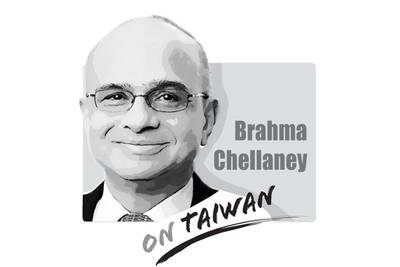With the Democratic Progressive Party’s (DPP) prospects of becoming the next ruling party having brightened considerably after the Nov. 29 nine-in-one elections last year, pundits and academics are wasting no time to say that the biggest obstacle to its takeover of the presidency will be its cross-strait policy, or the lack thereof.
It is without doubt important for the next government to have a systematic and well-considered policy framework underlying its dealings with Taiwan’s powerful neighbor, but it is equally worrying that some are eager to show their willingness to be led by the Chinese government in terms of the “unification agenda.”
A professor who had served as the DPP government’s Mainland Affairs Council vice minister advised the DPP to forgo the Taiwan independence clause in its party charter and entertain “the possibility of unification,” in an article published in the pro-unification China Times on Monday.
He called for the construction of a “Chinese identity” (huaren, 華人) to underlie the consolidation of cross-strait interactions.
Echoing former DPP chairman Frank Hsieh’s (謝長廷) proposal of “two constitutions, different interpretations” (憲法各表), and upholding the ROC Constitution — which has a fuzzy vision of the nation’s territory — as Taiwan’s preferred stance on the issue for a cross-strait consensus, the professor (like others who envision the future cross-strait relationship along the same lines) went further than necessary by introducing the “non-exclusion of the possibility of ‘unification’” to the constitution-based formula.
If ambiguity is what you need, the ROC Constitution alone suffices. There is no need for Taiwan to be led by the nose by China to expound on the idea and impose further constraints — even if nominal — on Taiwan’s future.
The non-exclusion clause might sound harmless and neutral, but what it stands for is docile submission to China’s hardline position on its national myth. Anyone could test the harmless-sounding non-exclusion clause with the idea of independence and would surely get an immediate repudiative response from an enraged China. If the possibility of unification should not be excluded as a sign of openness, why should the possibility of de jure independence be? The answer is obvious.
It is common knowledge in Taiwan that the nation requires a gray area for diplomatic maneuvers, and amid such a gross power imbalance, making the picture clearer in the favor of the other side is the last thing we need.
Also to go on history’s scrapheap is the touting of a huaren identity, which is not only an outdated concept for Taiwanese — especially for the younger generations — but also a misleading one for both nations.
Like the support for this nation’s leader, who has been a fervent believer, the concept of a “Chinese ethnic group” (zhonghua minzu, 中華民族) is on the way to its demise in Taiwan.
Despite the persistence of the Chinese-Han hegemony, many in Taiwan — especially younger members of Aboriginal groups — have been more conscious than ever of their cultural heritage and ethnic roots and of new immigrants, striving to cultivate a new national community not based on ethnicity.
There are serious impediments to the ideal, as recently shown by the practice of law enforcement authorities’ disrespectful treatment of some Aboriginal hunting rituals, but the differences are recognized and improvements encouraged. Regressing to a monocultural Chinese identity would not only take its toll on the nation’s cultural diversity and liberalism, but could also make Taiwanese complicit in Beijing’s repression against ethnic minorities in China.

Donald Trump’s return to the White House has offered Taiwan a paradoxical mix of reassurance and risk. Trump’s visceral hostility toward China could reinforce deterrence in the Taiwan Strait. Yet his disdain for alliances and penchant for transactional bargaining threaten to erode what Taiwan needs most: a reliable US commitment. Taiwan’s security depends less on US power than on US reliability, but Trump is undermining the latter. Deterrence without credibility is a hollow shield. Trump’s China policy in his second term has oscillated wildly between confrontation and conciliation. One day, he threatens Beijing with “massive” tariffs and calls China America’s “greatest geopolitical
Ahead of US President Donald Trump and Chinese President Xi Jinping’s (習近平) meeting today on the sidelines of the APEC summit in South Korea, an op-ed published in Time magazine last week maliciously called President William Lai (賴清德) a “reckless leader,” stirring skepticism in Taiwan about the US and fueling unease over the Trump-Xi talks. In line with his frequent criticism of the democratically elected ruling Democratic Progressive Party — which has stood up to China’s hostile military maneuvers and rejected Beijing’s “one country, two systems” framework — Lyle Goldstein, Asia engagement director at the US think tank Defense Priorities, called
A large majority of Taiwanese favor strengthening national defense and oppose unification with China, according to the results of a survey by the Mainland Affairs Council (MAC). In the poll, 81.8 percent of respondents disagreed with Beijing’s claim that “there is only one China and Taiwan is part of China,” MAC Deputy Minister Liang Wen-chieh (梁文傑) told a news conference on Thursday last week, adding that about 75 percent supported the creation of a “T-Dome” air defense system. President William Lai (賴清德) referred to such a system in his Double Ten National Day address, saying it would integrate air defenses into a
The central bank has launched a redesign of the New Taiwan dollar banknotes, prompting questions from Chinese Nationalist Party (KMT) legislators — “Are we not promoting digital payments? Why spend NT$5 billion on a redesign?” Many assume that cash will disappear in the digital age, but they forget that it represents the ultimate trust in the system. Banknotes do not become obsolete, they do not crash, they cannot be frozen and they leave no record of transactions. They remain the cleanest means of exchange in a free society. In a fully digitized world, every purchase, donation and action leaves behind data.